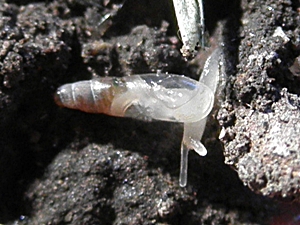
Common blind snail (Cecilioides acicula). Height ca. 3.5 mm.
Picture: Michal Maňas. Source: Michal Maňas Posterous Blog.
 Common blind snail (Cecilioides acicula). Height ca. 3.5 mm. Picture: Michal Maňas. Source: Michal Maňas Posterous Blog. |
Ground snails are tiny and small snails with a slender turricular shell with a thin wall. Interestingly enough, the Ferussaciidae, named after the French naturalist and malacologist André Étienne d'Audebard de Férussac (1786 - 1836), belong to the superfamily Achatinoidea, together with the giant African land snails (Achatinidae), the largest land snails there are. Subterraneous species of this family distributed worldwide in warm and temperate climates, are blind.
Class:
Gastropoda
![]() Subclass:
Pulmonata
Subclass:
Pulmonata
![]() Superorder:
Eupulmonata
Superorder:
Eupulmonata
![]() Order:
Stylommatophora
Order:
Stylommatophora
![]() Suborder:
Sigmurethra
Suborder:
Sigmurethra
![]() Infraorder:
Achatinoinei
Infraorder:
Achatinoinei
![]() Superfamily:
Achatinoidea
Superfamily:
Achatinoidea
![]() Family:
Ferussaciidae Bourguignat
1883
Family:
Ferussaciidae Bourguignat
1883
![]() Source: Mollbase on
http://www.mollbase.de/list/.
Source: Mollbase on
http://www.mollbase.de/list/.
Common Blind Snail - Cecilioides acicula (O. F. Müller 1774)
  Cecilioides acicula. Picture: H. Nisters. |
Description: The common blind snail has a needle shaped fragile and colourless shell, which after the snail's death becomes opaque and then milky white. The aperture takes about one third of the shell height. The columella is blunted and curved.
Dimensions: H: 5 mm; W: 1 - 1.4 mm; N: 6 - 7. (Abbreviations).
Habitat and Distribution: Blind snails live in the earth, in the hollow spaces of loose ground. They are hidden below stones, on roots or bones. Empty shells sometimes can be found in the humus at the foot of rocks, around plant tussocks, in molehills, as well as in alluvial deposits at the riverside. The blind snail mainly feeds on aspergillum fungi and uses the tubes of earth worms and larger ground pores to advance in depths of between 40 cm and 1 m.
Cecilioides acicula is distributed throughout the Mediterranean, as well as in warm and dry regions of Central and Eastern Europe. In the north, the species' distribution area stretches as far as Ireland, England and the south of Scandinavia. In the Alps the blind snail may appear in altitudes of up to 1300 m MSL.
![]() Anderson, R. (2008): "An annotated list of the non-marine Mollusca of Britain and
Ireland" (PDF).
Anderson, R. (2008): "An annotated list of the non-marine Mollusca of Britain and
Ireland" (PDF).